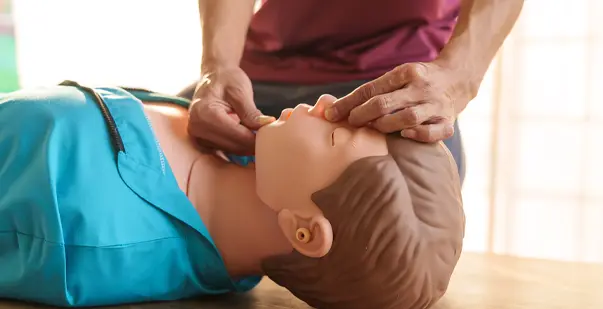Table of Content(s)
- What is a BLS Certification?
- Basic Life Support: Why is it important?
- BLS Certification: Easy Steps To Enroll
- Emergencies That Need Immediate BLS Intervention
- BLS Recertification: Important things to keep in mind
- Basic Life Support: Top BLS FAQS
- Conclusion
Imagine you are in a crowded restaurant when suddenly your friend collapses. As panic continues, precious seconds tick away. Now think of a different environment. Someone steps forward confidently, they assess the situation and begin performing basic life support (BLS). The difference between two scenarios depends on one factor- Basic Life Support.
Now what is BLS? BLS meaning Basic Life Support is a certification that equips individuals with the skills to respond effectively in emergencies like cardiac arrests, strokes or respiratory attacks. Performing effective BLS on time saves 50,000 people before medical help arrives. While several people associate BLS certification only with healthcare providers, anyone and everyone can benefit from this credential.
In this blog, we will find out in-depth what BLS certification is and why it is extremely important for both healthcare and non-healthcare professionals.
Basic Life Support: Why is it important?
Emergencies are uncalled for. Staying prepared for unfortunate events can make the difference between life and death. Consisting of important techniques like- cardiopulmonary resuscitation and AED usage, BLS helps maintain circulation and breathing in a person experiencing cardiac arrest. BLS is critical for ensuring timely and effective intervention during emergencies:
- Saves Lives in Critical Moments: BLS techniques, such as chest compressions and rescue breaths, help maintain oxygen flow to the brain and other vital organs. This buys time until advanced medical help arrives.
- Accessible to Everyone: You don’t need to be a medical professional to learn BLS. With proper training, anyone can perform these life-saving actions in an emergency.
- Prevents Brain Damage: Immediate application of BLS can prevent severe brain damage caused by a lack of oxygen. This improves the chances of full recovery for the patient.
- Supports Public Safety: Widespread knowledge of BLS in communities enhances public safety. This ensures that more people are capable of responding to emergencies in various settings.
- Increases Confidence in Emergencies: Being trained in BLS equips you with the confidence to act quickly and effectively. This reduces the hesitation that often occurs in high-stress situations.
- Required for Healthcare Professionals: BLS certification is a mandatory requirement for many healthcare roles. It ensures that professionals are prepared to respond to emergencies at any time.
Read More: BLS Certification for Physical Therapy
What are the steps to enroll for BLS certification?
If you move ahead with the right information, enrolling for a BLS certification is easy. Your one initiative can make a huge difference to the life of others and those around you. Here’s the guide that can help you get started:
- Research Accredited Providers: Start by finding reputable organizations that offer BLS certification.
- Choose Your Learning Format: Decide whether you prefer in-person classes, online courses, or a blended learning approach that combines both.
- Check Course Requirements: Ensure you meet any requirements like age limits or basic knowledge of CPR, before enrolling.
- Register Online: Visit the provider’s website to sign up for the course that best fits your schedule and learning style.
- Complete the Coursework: Engage with the course material. This typically includes instructional videos, interactive modules, and practical exercises.
- Attend the Skills Session: If you’re taking a blended or in-person course, you’ll need to demonstrate your skills in a live session to pass.
- Take the Final Exam: Pass the written exam to demonstrate your understanding of BLS protocols and procedures.
- Receive Your Certification: Upon successful completion, you’ll receive your BLS certification card, valid for two years.
Read More: How To Get BLS Certification?
Emergencies That Need Immediate BLS Intervention
Basic Life Support is the first important line of defense for several emergencies. To make the most out of your BLS training, it is important to know which emergencies demand immediate BLS intervention:
- Cardiac Arrest: Sudden loss of heart function requires prompt CPR and defibrillation to restore circulation and increase the chances of survival.
- Choking: When someone’s airway is blocked, quick application of the Heimlich maneuver or back blows can dislodge the object and prevent suffocation.
- Drowning: Immediate rescue breathing and CPR are essential to restore oxygen flow and prevent brain damage in a drowning victim.
- Severe Allergic Reactions (Anaphylaxis): Rapid administration of CPR and the use of an EpiPen can save a person experiencing anaphylactic shock.
- Respiratory Arrest: If someone stops breathing, rescue breathing or bag-mask ventilation must be initiated immediately to maintain oxygen levels.
- Drug Overdose: In cases of opioid overdose, BLS interventions, including the administration of naloxone and supportive breathing, can be life-saving.
- Severe Trauma: Major injuries, especially those involving severe bleeding or shock, require immediate BLS to stabilize the patient until emergency services arrive.
- Electric Shock: Victims of electric shock may experience cardiac arrest or respiratory failure. This requires urgent BLS to restore normal function.
BLS Recertification: Important things to keep in mind
Just getting BLS certified isn’t enough. It is equally important to keep the certification updated to ensure efficient practice that abides by the industry standards. BLS certification typically expires after 2 years. It is important to apply for recertification before your current certification is about to expire. Performing BLS without a valid certification can lead to serious legal consequences.
These are the important things to keep in mind:
- Know Your Expiration Date: Keep track of your current certification’s expiration date to ensure you renew on time. It’s recommended to start the recertification process a few months before it expires.
- Choose the Right Course Format: Decide whether you prefer an in-person recertification class, an online course, or a blended option that includes both online learning and a hands-on skills session.
- Check for Updated Guidelines: BLS protocols are periodically updated based on the latest medical research. Make sure your recertification course covers any new guidelines or changes in best practices.
- Practice Skills Regularly: Even before your recertification course, it’s beneficial to regularly practice BLS skills, such as CPR and AED use, to maintain proficiency.
- Prepare for the Skills Test: Most recertification courses require you to pass a skills test. Practice beforehand to ensure you can confidently demonstrate your abilities.
- Complete Any Required Pre-Course Work: Some recertification courses may include pre-course materials or assessments that need to be completed before attending the class or skills session.
- Ensure Your Provider is Accredited: Make sure the organization offering the recertification is accredited and updated as per industry guidelines.
- Consider Group Recertification: If you’re part of a team or organization, consider arranging group recertification sessions to streamline the process and ensure everyone is up-to-date.
- Keep a Copy of Your Certification: Once you pass the recertification course, make sure to keep a digital and physical copy of your certification card for easy access.
- Plan for Continuing Education: BLS recertification is also a good time to consider additional training or certifications, such as Advanced Cardiovascular Life Support (ACLS) or Pediatric Advanced Life Support (PALS).
- Update Your Employer: If BLS certification is a job requirement, be sure to inform your employer of your recertification and provide them with a copy of your updated certification.
- Renew Your Certification on Time: Avoid lapses in your certification by completing your recertification before your current one expires. This ensures you’re always prepared and qualified to respond in emergencies.
- Take Advantage of Refresher Resources: Many organizations offer refresher materials, such as videos or practice tests, to help you prepare for your recertification course.
- Understand the Costs: Be aware of the recertification costs, which can vary depending on the provider and course format. Some employers may cover these expenses, so check with your HR department.
- Stay Informed About Recertification Options: Look into different recertification options and requirements, especially if you’re considering switching providers or if your job has specific mandates.
Basic Life Support: Top BLS FAQs
- What is BLS?
- BLS stands for Basic Life Support, a level of medical care used to provide immediate assistance in life-threatening emergencies, such as cardiac arrest, choking, or drowning.
- Who should get BLS certified?
- BLS certification is recommended for healthcare professionals, first responders, teachers, lifeguards, and anyone interested in being prepared for emergencies.
- How long does BLS certification last?
- BLS certification is typically valid for two years, after which renewal is required to maintain certification.
- What does a BLS course cover?
- A BLS course covers CPR for adults, children, and infants, the use of an Automated External Defibrillator (AED), and how to assist choking victims.
- Is BLS the same as CPR?
- BLS includes CPR as a core component but also covers other essential skills, such as using an AED and managing airway obstructions.
- Can I take a BLS course online?
- Yes, many providers offer online BLS courses, often combined with in-person skills sessions to ensure practical competence.
- How long does it take to complete a BLS course?
- A typical BLS course takes about 4-5 hours to complete, depending on the provider and the format of the course.
- Do I need to take a test to get BLS certified?
- Yes, most BLS courses require passing a written exam and a skills test to demonstrate proficiency in BLS techniques.
- What is the difference between BLS and ACLS?
- BLS focuses on basic emergency care, while Advanced Cardiovascular Life Support (ACLS) involves more advanced interventions, including drug administration and managing complex cardiac conditions.
- Is BLS certification required for healthcare jobs?
- Yes, many healthcare positions require BLS certification as a minimum qualification, particularly for roles involving patient care.
- What should I wear to a BLS course?
- Wear comfortable clothing that allows you to perform physical activities like CPR and practicing on mannequins.
- Can I renew my BLS certification online?
- Yes, many organizations offer online renewal courses for BLS certification, often requiring a brief skills check in person.
- What happens if I let my BLS certification expire?
- If your BLS certification expires, you may need to retake the full course rather than just a renewal course to regain certification.
- Do BLS courses teach how to use an AED?
- Yes, the proper use of an AED is a key component of BLS training, alongside CPR and airway management.
- Where can I find BLS certification courses near me?
- You can find BLS courses through local hospitals, community centers, and the American Health Care Academy.
Conclusion
To answer – “What is BLS”, it is definitely more than just a credential. It is an essential skill set that empowers individuals to respond with confidence and competence in potentially fatal emergencies. Whether a healthcare professional or a concerned citizen, getting BLS certified can help you take the necessary step with utmost proficiency and precision. Being an invaluable investment towards oneself and the society, enroll in a BLS class today to stay safe and prepared.






